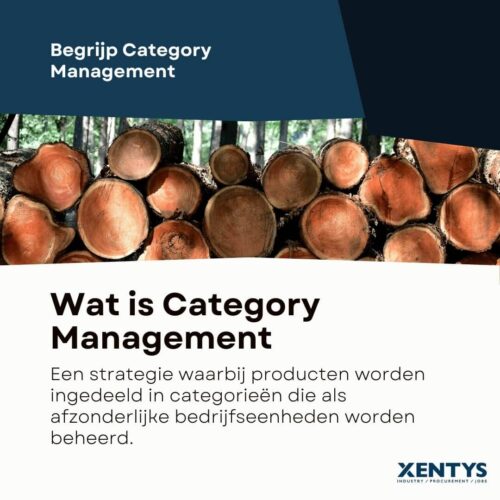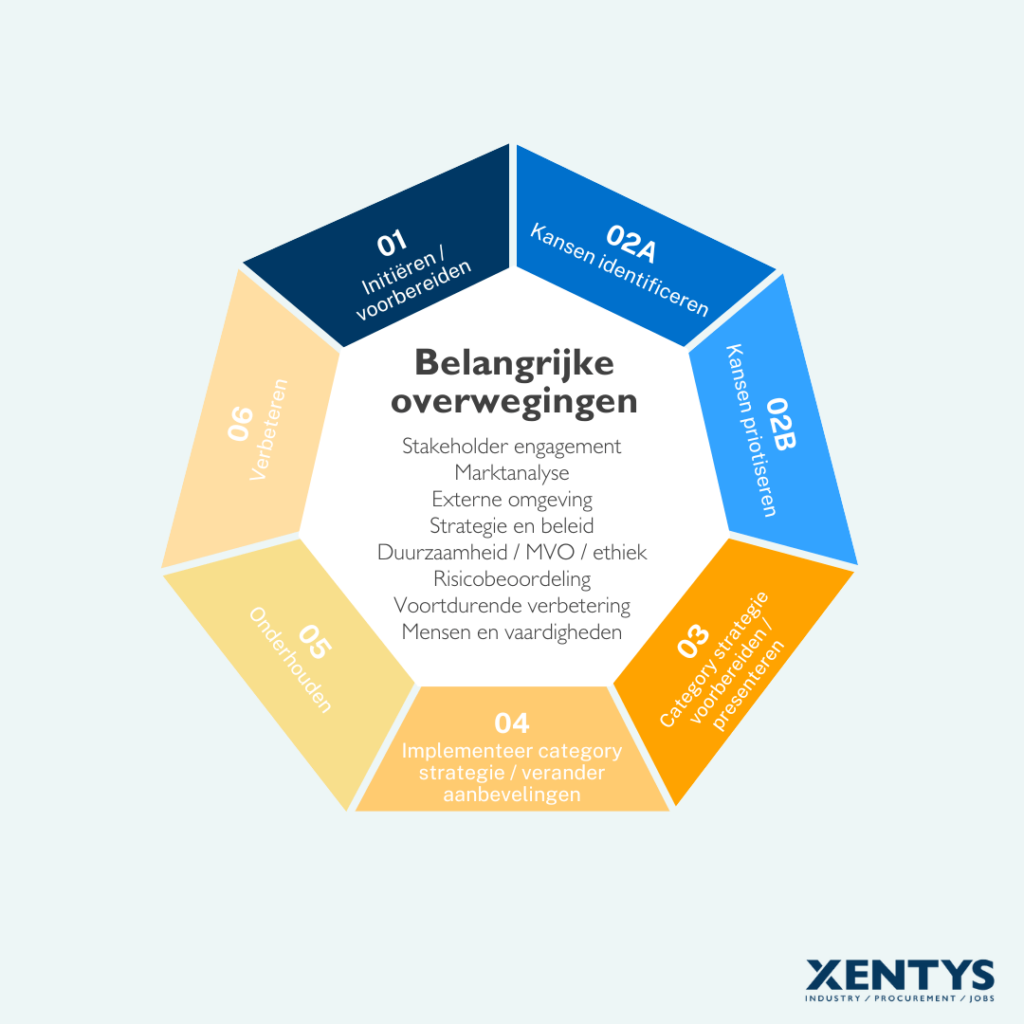Category Management
Category Management is a strategic approach that divides products into categories, each of which acts as separate business units. This methodology is crucial for procurement and supply chain processes. The goal is to manage each product category as a mini-company within the organization, with each segment having specific strategies and objectives.
What is Category Management?
This process includes identifying key categories within a company’s product range and developing customized strategies for purchasing, marketing and sales. By understanding market dynamics and consumer behavior, Category Management strives to maximize sales and profitability.
Collaboration between departments such as purchasing, marketing and sales is essential to achieving a coherent policy. This includes analyzing market trends, consumer needs and the performance of individual products. The ultimate goal is to optimize assortments, improve customer experience and efficiently manage inventory, with a constant focus on maximizing value for both consumers and the company.
The Category Manager plays a central role in this and is responsible for overseeing the strategies for each product category, from planning and sourcing to marketing and sales. By working closely with suppliers and using cross-functional teams, organizations can respond faster to customer needs, drive innovation and achieve sustainable results. Agile Procurement not only supports an efficient procurement model, but also contributes to the overall agility and competitiveness of the organization.

FREE WHITE PAPER
How to Make a Category Plan
The Profound Workings of Category Management
Understanding Category Management
Category Management goes beyond simply classifying products. It is an integrated approach that incorporates the entire chain from product development to consumer experience. An effective policy contributes to closer cooperation between suppliers and retailers, leading to better alignment of product offerings with market demand.
Role of the Category Manager
The Category Manager plays a key role in this process. That person analyzes market trends, consumer behavior, and competitive dynamics to create a strategic plan for each category. This includes choosing product assortments, pricing, promotional strategies, and determining optimal shelf space and placement in-store or online.
Strategies and Tools
Through advanced tools and data analysis, Category Managers identify opportunities for growth and efficiency improvements. This could mean, for example, focusing on high-value products in a particular category or implementing promotions to boost sales. They also work closely with purchasing departments to optimize product sourcing, taking into account factors such as cost, quality and sustainability.
Collaboration and Synergy
Another important component is collaboration between different departments within an organization. Category Managers often work hand-in-hand with marketing teams to develop effective campaigns that highlight the unique characteristics of each product category. They also play a crucial role in working with suppliers, striving for long-term relationships.
Cooperation with suppliers
Another important aspect of category management is collaboration with suppliers. Suppliers are a valuable source of information and can help develop new products and concepts that meet market needs. By building strong relationships with suppliers, category managers can negotiate better terms and improve the quality of their offerings.
In addition, it is essential to communicate regularly with suppliers about product performance, inventory levels and market developments. This ensures that both retailer and supplier are aware of changes and can support each other in achieving their goals.
Importance of data analysis
Data analysis is an important aspect of category management. By collecting and analyzing data, organizations can identify trends and patterns that help them make informed decisions. This can include using software such as Ariba Category Management, which allows companies to streamline their purchasing processes and gain better insights into their product categories.
The use of analytics also enables in-depth analysis of customer behavior, market dynamics and competition. This information is crucial for developing an effective category vision and making strategic decisions that improve product category performance.
Response to Consumer Needs
In a consumer-centric era, adapting categories to changing consumer needs and preferences is essential. Category Managers must be constantly alert to shifts in the market and be able to respond quickly with adjustments to their strategies. This could be introducing new products or adjusting pricing strategies.
Challenges and Opportunities
Category Management also brings challenges, especially in rapidly changing markets. Managers must be flexible and adaptive, able to respond quickly to new trends and changes in consumer behavior. At the same time, this dynamic field offers opportunities for innovation and creativity, where managers can develop new concepts and approaches to gain competitive advantage.
Conclusion
Category Management is a dynamic approach crucial to the success of modern businesses. By strategically focusing on product categories, companies can refine their offerings, better respond to market needs, and ultimately improve their profitability and market position. With the right mix of market insight, planning, and collaboration, Category Managers can play a key role in an organization’s success in the increasingly complex landscape of procurement and supply chain management.

FREE WHITE PAPER
Reduce Total Cost of Ownership (TCO) with the Kraljic Matrix
Frequently Asked Questions about Category Management
What is the main purpose of Category Management?
The primary goal of Category Management is to maximize the value and efficiency of a product category through data-driven decisions and strategic planning. This includes optimizing product assortments, pricing, and promotions to meet consumer needs and increase profitability.
How is Category Management different from traditional product management?
Unlike traditional product management, which often focuses on individual products, Category Management looks at products as part of a broader category. This provides a holistic approach that takes into account the relationships between different products and how they may affect each other within the category.
What role does a Category Manager play?
A Category Manager is responsible for managing a specific product category. This includes analyzing market trends, developing strategies for assortment management, pricing, and promotions, and working with purchasing and marketing teams to optimize overall category performance.
How are decisions made in Category Management?
Decisions within Category Management are data-driven. Managers use market analysis, consumer insights, and financial data to develop strategies aimed at improving category performance. These decisions may involve assortment changes, price adjustments, promotional strategies, and supply chain optimization.
What is the impact of Category Management on the supply chain?
Category Management can have a significant impact on the supply chain by better forecasting demand and optimizing inventory management. This leads to more efficient inventory levels, reduced storage costs, and improved product availability for consumers.
How does Category Management contribute to customer satisfaction?
By focusing on consumer needs and preferences, Category Management can increase customer satisfaction. This is achieved by offering a carefully curated product assortment, optimizing prices, and adapting promotions that resonate with the target audience.
What are the challenges in implementing Category Management?
Some of the challenges include continuously keeping up with changing market trends and consumer behavior, integrating large amounts of data for decision-making, and ensuring collaboration between different departments within an organization.
Can Category Management be applied in all types of businesses?
Yes, Category Management can be applied in a wide range of businesses, from retail to B2B enterprises. The principles and strategies can be adapted to the specific needs and characteristics of different markets and product categories.
How does technology affect the practice of Category Management?
Technological developments, such as big data analytics, AI and machine learning, have significantly expanded the possibilities for Category Management. They enable managers to perform in-depth analysis, make accurate predictions, and develop more personalized strategies.
What are the future trends in Category Management?
There will be a greater emphasis on sustainability within categories, the use of advanced data analytics techniques, and the integration of omnichannel strategies to provide a seamless consumer experience both online and offline.
How does an open application work at xentys?
Submitting an open application will keep you informed of our current job openings and allow us to band you when we have a suitable position for you.
How to get started?
1.
First, make sure your resume succinctly reflects all your relevant skills, qualifications and experience.
2.
Then submit the open application to us using the form to the right. You may then receive a call from one of our recruitment specialists.
3.
Above all, remain patient, because finding the appropriate job opening may take some time.
4.
At xentys, we want to inform you about the job opening that suits you.
What an open application at xentys can bring you
Would you like to receive customized procurement job openings or would you prefer to see a general overview of all job openings? At xentys, we provide an individualized approach. We organize an interview with one of our specialists to get a good picture of your abilities, qualifications and preferences before we introduce you to an employer or client.



